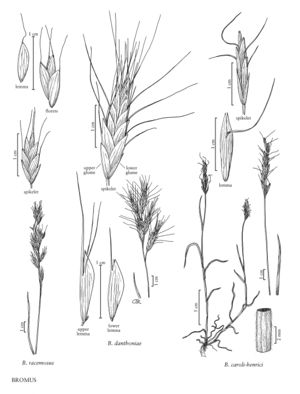Difference between revisions of "Bromus caroli-henrici"
FNA>Volume Importer |
imported>Volume Importer |
||
| (4 intermediate revisions by 2 users not shown) | |||
| Line 1: | Line 1: | ||
{{Treatment/ID | {{Treatment/ID | ||
|accepted_name=Bromus caroli-henrici | |accepted_name=Bromus caroli-henrici | ||
| − | |accepted_authority= | + | |accepted_authority= |
|publications= | |publications= | ||
|basionyms= | |basionyms= | ||
|synonyms={{Treatment/ID/Synonym | |synonyms={{Treatment/ID/Synonym | ||
|name=Bromus alopecuros | |name=Bromus alopecuros | ||
| − | |authority= | + | |authority= |
| + | |rank=species | ||
}} | }} | ||
|hierarchy=Poaceae;Poaceae subfam. Pooideae;Poaceae tribe Bromeae;Bromus;Bromus sect. Bromus;Bromus caroli-henrici | |hierarchy=Poaceae;Poaceae subfam. Pooideae;Poaceae tribe Bromeae;Bromus;Bromus sect. Bromus;Bromus caroli-henrici | ||
| Line 18: | Line 19: | ||
-->{{Treatment/Body | -->{{Treatment/Body | ||
| − | |discussion=<p>Bromus caroli-henrici is native to Mediterranean Europe. In the Flora region, it grows in open, disturbed areas in Butte and Yolo counties, California. It has been misidentified as B. alopecuros Poir. It differs in having 1, rather than 2-3, spikelets at the rachis nodes, and acuminate, rather than broadly triangular, lemma teeth.</p> | + | |discussion=<p><i>Bromus caroli-henrici</i> is native to Mediterranean Europe. In the Flora region, it grows in open, disturbed areas in Butte and Yolo counties, California. It has been misidentified as B. alopecuros Poir. It differs in having 1, rather than 2-3, spikelets at the rachis nodes, and acuminate, rather than broadly triangular, lemma teeth.</p> |
|tables= | |tables= | ||
|references= | |references= | ||
| Line 27: | Line 28: | ||
-->{{#Taxon: | -->{{#Taxon: | ||
name=Bromus caroli-henrici | name=Bromus caroli-henrici | ||
| − | + | |authority= | |
| − | |authority= | ||
|rank=species | |rank=species | ||
|parent rank=section | |parent rank=section | ||
| Line 35: | Line 35: | ||
|family=Poaceae | |family=Poaceae | ||
|illustrator=Cindy Roché | |illustrator=Cindy Roché | ||
| + | |illustration copyright=Utah State University | ||
|reference=None | |reference=None | ||
|publication title= | |publication title= | ||
|publication year= | |publication year= | ||
|special status= | |special status= | ||
| − | |source xml=https:// | + | |source xml=https://bitbucket.org/aafc-mbb/fna-data-curation/src/200273ad09963decb8fc72550212de541d86569d/coarse_grained_fna_xml/V24/V24_334.xml |
|subfamily=Poaceae subfam. Pooideae | |subfamily=Poaceae subfam. Pooideae | ||
|tribe=Poaceae tribe Bromeae | |tribe=Poaceae tribe Bromeae | ||
Latest revision as of 16:23, 11 May 2021
Plants annual. Culms 10-40 cm, erect or ascending. Lower sheaths densely retrorsely villous-pubescent, upper sheaths glabrous; ligules 0.5-1 mm, glabrous, truncate, dentate or lacerate; blades 5-20 cm long, 1.5-4 mm wide, pilose, sparingly pubescent, or subglabrous. Panicles 6-15 cm long, 1-2 cm wide, racemose, dense, strongly contracted, stiffly erect; branches shorter than the spikelets, stiff, erect, straight. Spikelets 17-45 mm long, 4-7 mm wide, narrowly oblong or lanceolate, terete to moderately laterally compressed, usually 1 per node; florets (4)8-12, bases concealed at maturity; rachilla internodes concealed at maturity. Glumes glabrous or puberulent; lower glumes 7-9 mm, 3-veined, upper glumes 8-11 mm, 5-7-veined; lemmas 11-15(17) mm long, 3-5 mm wide, lanceolate, glabrous or pubescent, 9-veined, rounded over the midvein, margins bluntly angled, not inrolled at maturity, apices and teeth acuminate, teeth shorter than 1 mm; awns 12-20 mm, strongly divaricate at maturity, flattened and often basally twisted, arising 1.5 mm or more below the lemma apices; anthers 0.75-1.5 mm. Caryopses equaling or shorter than the paleas, thin, weakly inrolled or flat. 2n = 14, 28.
Discussion
Bromus caroli-henrici is native to Mediterranean Europe. In the Flora region, it grows in open, disturbed areas in Butte and Yolo counties, California. It has been misidentified as B. alopecuros Poir. It differs in having 1, rather than 2-3, spikelets at the rachis nodes, and acuminate, rather than broadly triangular, lemma teeth.
Selected References
None.
